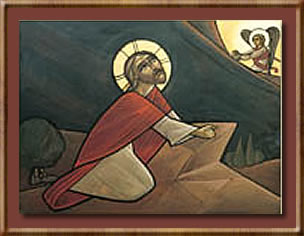- Arabic Corner
- Audio
- Bible Study
- Coptic Reader
- Children's Corner
- Deacons
- Evangelism & Apologetics
- Evangelism Pamphlets
- Interesting Facts
- Literature
- Pigori Productions
- Priests Corner
- Questions & Answers
- Reading Recommended
- Saintly Studies
- Servants Guide
- Sunday School Curriculum
- Sunday School Curriculum-Special Needs
- Youth Corner
Interesting Holy Bible Facts
40 Days and 40 Nights
by Fr. Shenouda Maher Ishak
 After our Lord Jesus Christ was baptized in the Jordan River by St. John the Baptist, "immediately the Spirit drove Him into the wilderness" where He spent forty days and forty nights (Mark 1:12-13; Matthew 4:1-2). This period of fasting was not unheard of since both Moses and Elijah fasted for forty days. Moses was on Mount Sinai for forty days and forty nights receiving the Law from God (Exodus 24:18) and then fasted for another forty days and forty nights when God had written the Law a second time (Exodus 34:28) after the first tablets were destroyed in the incident of the golden calf (Exodus 32:19). Elijah also fasted forty days and forty nights when he was fleeing from Jezebel, the wife of Ahab, king of Israel, after the contest of the sacrifice on Mount Carmel. "The angel of the Lord came back the second time, and touched him, and said, 'Arise and eat, because the journey is too great for you'. So he arose, and ate and drank; and he went in the strength of that food forty days and forty nights as far as Horeb, the mountain of God" (1 Kings 19:7-8).
After our Lord Jesus Christ was baptized in the Jordan River by St. John the Baptist, "immediately the Spirit drove Him into the wilderness" where He spent forty days and forty nights (Mark 1:12-13; Matthew 4:1-2). This period of fasting was not unheard of since both Moses and Elijah fasted for forty days. Moses was on Mount Sinai for forty days and forty nights receiving the Law from God (Exodus 24:18) and then fasted for another forty days and forty nights when God had written the Law a second time (Exodus 34:28) after the first tablets were destroyed in the incident of the golden calf (Exodus 32:19). Elijah also fasted forty days and forty nights when he was fleeing from Jezebel, the wife of Ahab, king of Israel, after the contest of the sacrifice on Mount Carmel. "The angel of the Lord came back the second time, and touched him, and said, 'Arise and eat, because the journey is too great for you'. So he arose, and ate and drank; and he went in the strength of that food forty days and forty nights as far as Horeb, the mountain of God" (1 Kings 19:7-8).
The early Coptic Church tradition was to fast the Great Fast for forty days beginning Tobe 12, the day after the Feast of Epiphany, according to the Biblical tradition that our Lord set by fasting forty days and forty nights after His baptism. However, since the Paschal Fast was fasted separately, Pope Demetrius, the 12th Patriarch, in agreement with Agapius, bishop of Jerusalem, Maximos, Patriarch of Antioch, and Victor, Patriarch of Rome, agreed to join the two fasts. Thus, the beginning of the Great Fast was determined by the date of the Feast of the Resurrection. Later, the Ecumenical Council of Nicaea, 325 A.D., commissioned the Patriarch of Alexandria to announce these dates in his Festal Letters to the other Sees.
The exact period of fasting for the Great Fast had differed amongst the different Churches during this period of time. For example, the Church of Alexandria fasted for six weeks according to the Festal Letters of St. Athanasius and was last documented in 577 A.D. during the patriarchate of Pope Damian. On the other hand, the Church of Jerusalem fasted for eight weeks as documented in the Pilgrimage of Egeria. At least from the time of Pope Benjamin (622-661 A.D.) the Church of Egypt fasted a total of eight weeks. This is most likely due to the common pilgrimages of the Copts to the Holy Land, thus bringing back with them the tradition of fasting for eight weeks as well as the influence of St. Severus of Antioch (c. 465-538) who lived in Egypt during his exile and was beloved by the Copts. He spoke of eight weeks of five days each to yield the number forty which was the same computation as mentioned by Egeria. This calculation is the result of strict abstinence from food during the five days in the week but not on Saturday and Sunday.
For more details on this topic, please see "Liturgical and Ritual Issues and Proposals Concerning the Restoration of Communion" by Fr. Shenouda Maher Ishak, pp. 82-90.